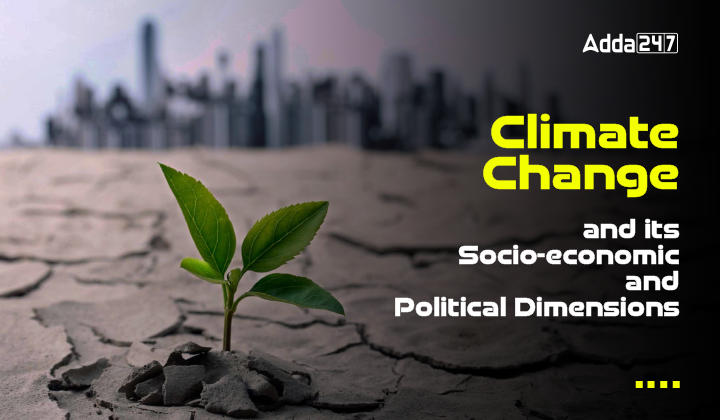Table of Contents
Climate change is a complex issue with wide-ranging socio-economic and political dimensions. It refers to long-term changes in temperature and weather patterns across the globe, primarily caused by human activities such as the burning of fossil fuels, deforestation, and industrial processes.
Climate change, with its socio-economic and political dimensions, has emerged as a critical issue globally. It is affecting various aspects of society, economies, and political systems, and India, as one of the world’s most populous countries and a rapidly developing nation, is not exempt from its impacts. Let’s explore the socio-economic and political aspects of climate change.
Socio-Economic dimensions
The socio-economic dimensions of climate change refer to the ways in which climate change affects societies and economies, and how social and economic factors influence vulnerability to and adaptation strategies for climate change. Here are some key socio-economic dimensions of climate change:
Impacts on Livelihoods and Economic Sectors:
- Climate change can have significant impacts on livelihoods and economic sectors.
- Changes in temperature and precipitation patterns can affect agriculture, forestry, fisheries, and other primary industries.
- Extreme weather events can damage infrastructure, disrupt supply chains, and lead to economic losses.
- Vulnerable populations, particularly those dependent on natural resources, are often disproportionately affected.
Impact on human health:
- Climate change impacts human health.
- Increased temperatures can lead to heat waves, affecting vulnerable populations, such as the elderly and those with pre-existing health conditions.
- Changing disease patterns, including the spread of vector-borne diseases like dengue and malaria, are also linked to climate change.
Displacement and Migration:
- Climate change can contribute to population displacement and migration.
- Rising sea levels, droughts, and other climate-related factors can render certain areas uninhabitable, leading to forced displacement.
- Climate-induced migration can strain social and economic systems, with potential implications for host communities and displaced populations.
- Socioeconomic factors play a role in determining the ability of individuals and communities to adapt or relocate in response to climate change.
Poverty and Inequality:
- Climate change can exacerbate poverty and widen existing socioeconomic inequalities.
- Poorer communities often lack the resources and infrastructure to cope with climate impacts, such as access to clean water, adequate housing, or healthcare.
- Climate-related disasters can push people deeper into poverty, especially in developing countries.
Political dimensions
Climate change is a complex and multifaceted issue that intersects with various political dimensions. Here are some key political dimensions related to climate change:
International engagement:
- Climate change has important political dimensions, both nationally and internationally. Globally, countries engage in negotiations and agreements to address climate change collectively.
- These negotiations involve countries with diverse interests and varying levels of responsibility for historical emissions. India participates in international climate negotiations and agreements, such as the United Nations Framework Convention on Climate Change (UNFCCC) and the Paris Agreement.
- Political dimensions include diplomatic efforts to reach a consensus, negotiation of emission reduction targets, and financial commitments to support climate action in developing nations.
National political measures:
- At the national level, India has taken several political measures to address climate change. The National Action Plan on Climate Change (NAPCC) was launched in 2008, outlining eight missions covering various sectors.
- For instance, the National Solar Mission aims to promote the adoption of solar energy and achieve 175 GW of renewable energy capacity by 2022. The Pradhan Mantri Ujjwala Yojana, a government scheme, aims to provide clean cooking fuel to reduce indoor air pollution, benefiting both health and the environment.
Public Opinion and Activism:
- Public opinion and activism play a crucial role in shaping political responses to climate change.
- Grassroots movements, advocacy groups, and public pressure can influence political agendas, push for stronger climate policies, and hold governments accountable for their actions or inactions on climate change.
- Political dimensions also encompass debates around climate scepticism, the role of science in policy-making, and the framing of climate change as a political issue.
Indian legislations:
| Act | Details |
| National Green Tribunal (NGT) Act, 2010 |
|
| Energy Conservation Act, 2001 |
|
| Forest Rights Act, 2006 |
|
What is UNFCCC
The UNFCCC, or the United Nations Framework Convention on Climate Change, is an international treaty aimed at addressing global climate change. It was adopted at the Earth Summit in Rio de Janeiro, Brazil, in 1992 and entered into force in 1994. The UNFCCC serves as the foundation for international efforts to combat climate change and is one of the key agreements in the global climate change framework. The UNFCCC also established the annual Conference of the Parties (COP) meetings, where member countries come together to discuss and negotiate climate-related issues.
- Purpose: The UNFCCC is an international treaty aimed at addressing global climate change and its impacts.
- Adoption: It was adopted at the Earth Summit in Rio de Janeiro, Brazil, in 1992.
- Entry into Force: The convention entered into force on 21 March 1994.
- Objective: The primary objective of the UNFCCC is to stabilize greenhouse gas concentrations in the atmosphere at a level that prevents dangerous anthropogenic interference with the climate system.
- Mitigation: Parties commit to taking measures to reduce greenhouse gas emissions. Developed countries have specific responsibilities to take the lead in emission reductions.
- Adaptation: Recognizes the need to adapt to the impacts of climate change, especially in vulnerable regions
What is Paris Agreement
The Paris Agreement is a landmark international treaty aimed at addressing climate change. It was adopted on 12 December 2015, at the 21st Conference of the Parties (COP 21) to the United Nations Framework Convention on Climate Change (UNFCCC) in Paris, France. The agreement entered into force on 4 November 2016.
The Paris Agreement is a pivotal international treaty that aims to unite countries in the global effort to combat climate change. It builds upon the United Nations Framework Convention on Climate Change (UNFCCC) and emphasizes cooperative action, transparency, and the pursuit of more ambitious climate goals over time.
- Adoption Date: The Paris Agreement was adopted on December 12, 2015, during the 21st Conference of the Parties (COP 21) to the United Nations Framework Convention on Climate Change (UNFCCC) in Paris, France.
- Entry into Force: The agreement entered into force on November 4, 2016, less than a year after it was adopted. This rapid entry into force demonstrated strong international support.
- Signatories: As of my last knowledge update in September 2021, 196 countries had signed the Paris Agreement. These countries are referred to as Parties to the agreement.
- Global Collaboration: The Paris Agreement is the first universal climate accord, bringing together both developed and developing countries in a common effort to address climate change.
- Temperature Targets: The agreement’s central goal is to limit global warming to well below 2 degrees Celsius above pre-industrial levels and to pursue efforts to limit it to 1.5 degrees Celsius. This is considered a more ambitious target than previous climate agreements.
- Nationally Determined Contributions (NDCs): Parties are required to submit their NDCs, which are specific climate action plans outlining their targets and strategies for reducing greenhouse gas emissions and adapting to climate change. These are revised and updated regularly.
In conclusion, climate change’s socio-economic and political dimensions are evident globally and in India. Socio-economic consequences impact vulnerable populations, agriculture, coastal regions, and human health. Politically, India engages in global climate negotiations while balancing development priorities. The country has enacted legislation such as the NGT Act, Energy Conservation Act, and Forest Rights Act to address climate change and promote sustainable practices. These measures aim to mitigate climate impacts, promote renewable energy, and protect the environment, demonstrating India’s commitment to addressing this pressing challenge.
Download UGC NET Study Notes Paper 1 PDF
The direct link to download UGC NET Study Notes Paper 1 PDF has been given below.




 Phases of Teaching - Stages of Teaching ...
Phases of Teaching - Stages of Teaching ...
 स्वर व व्यंजन - �...
स्वर व व्यंजन - �...
 UP TGT Sanskrit Syllabus and Exam Patter...
UP TGT Sanskrit Syllabus and Exam Patter...




